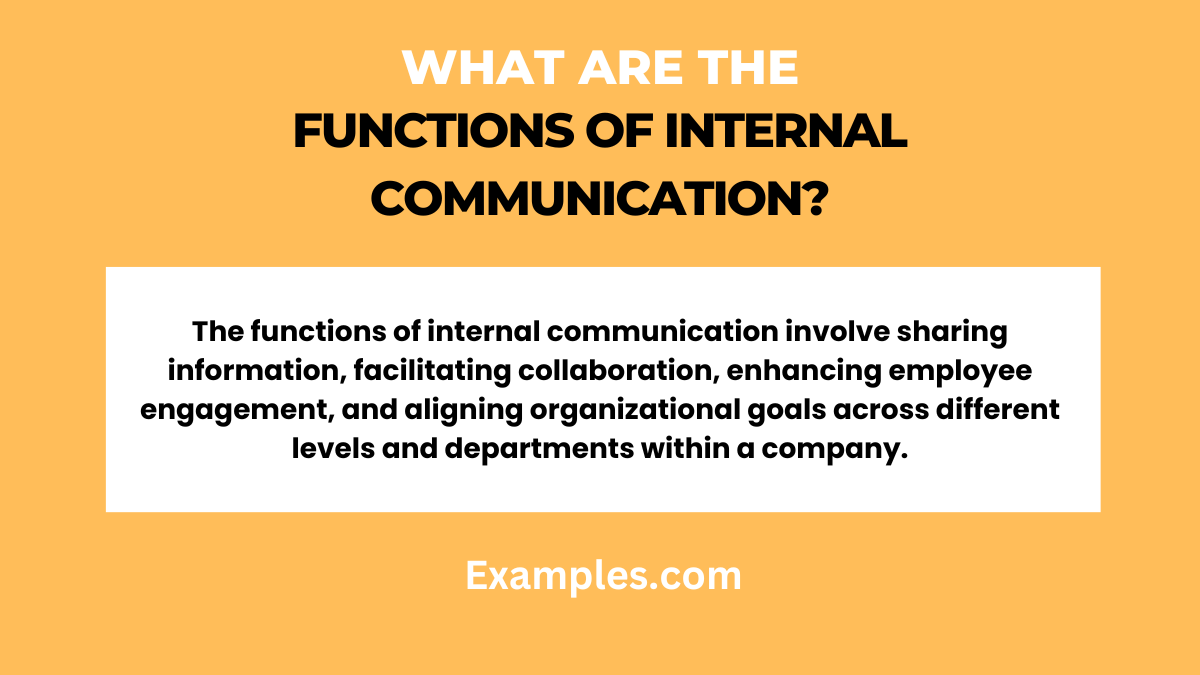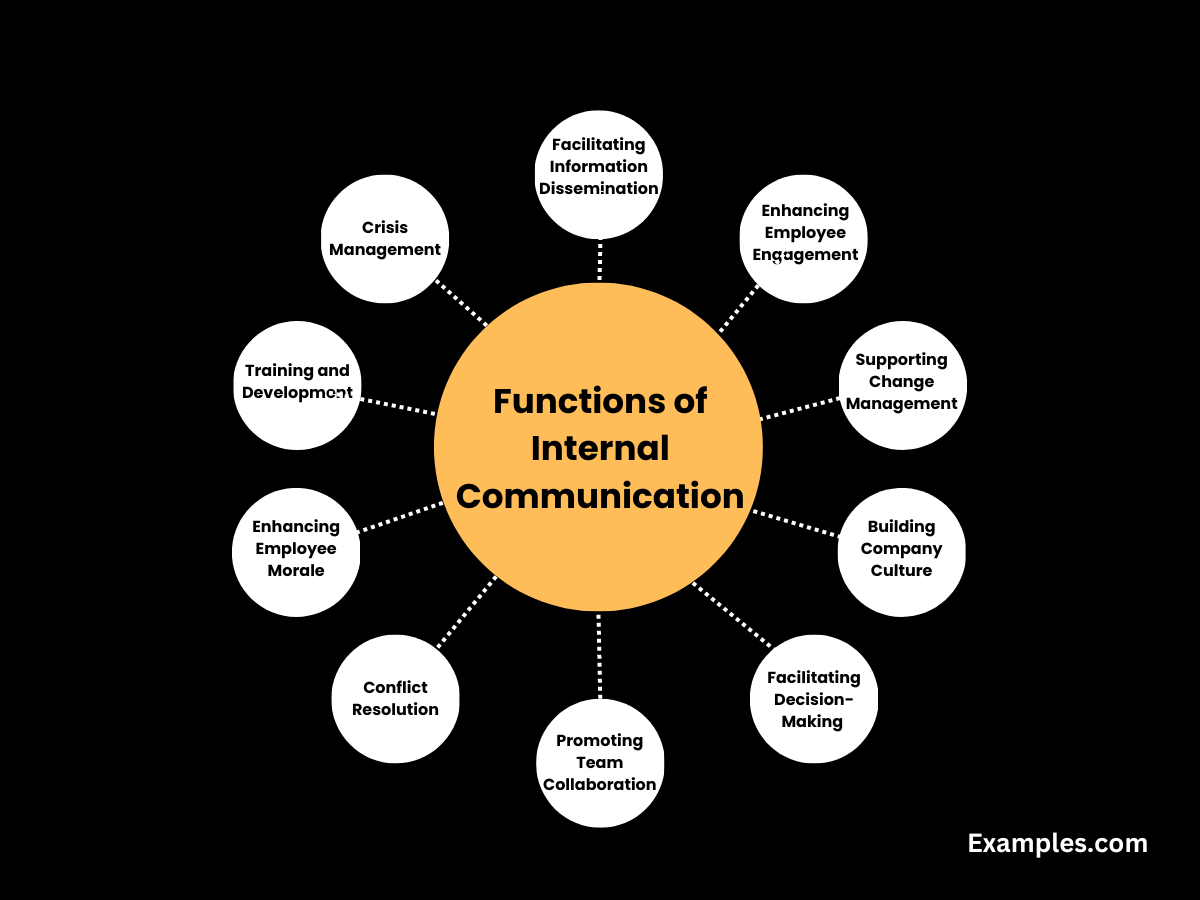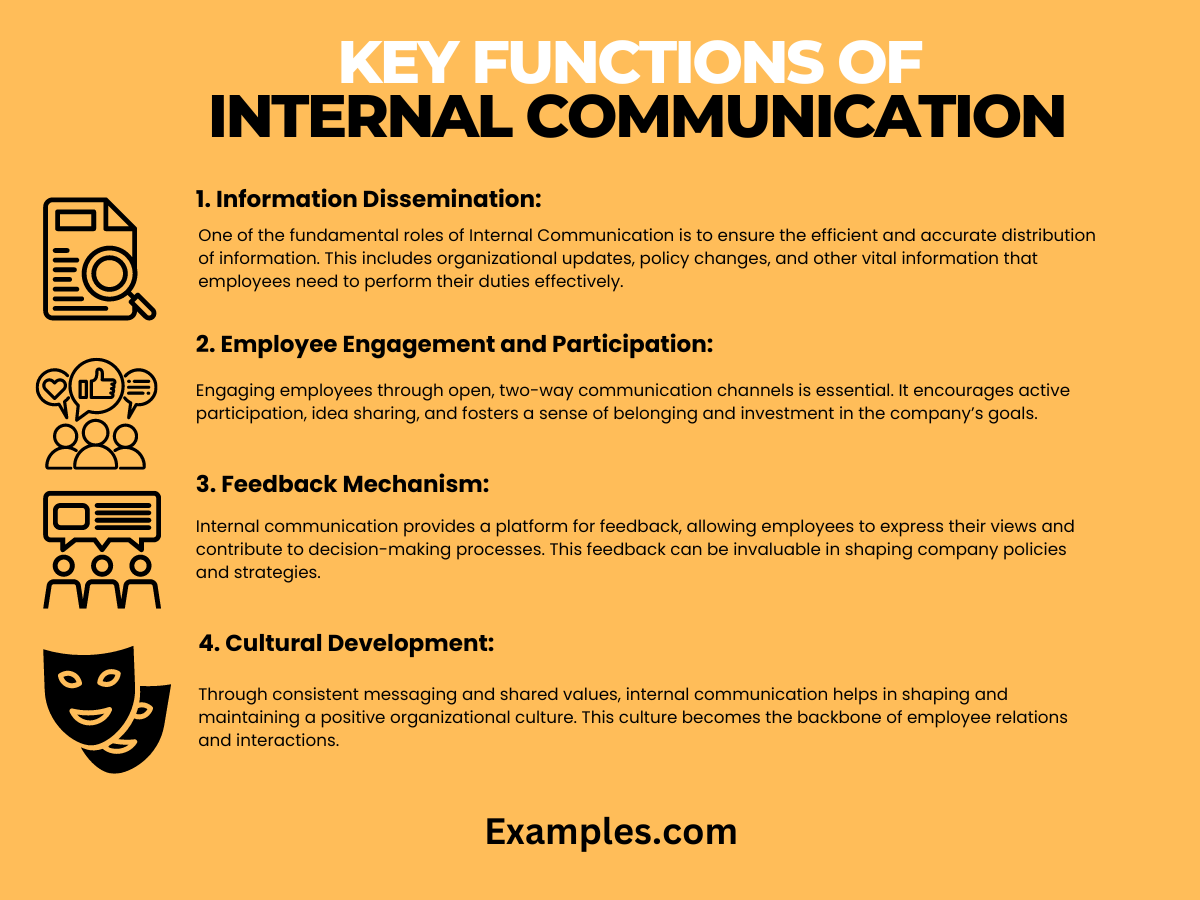9+ Internal Communication Functions Examples
Discover the comprehensive world of Internal Communication Functions through this enlightening guide. Delve into the myriad of ways internal communication shapes the dynamics of an organization. With practical Internal Communication Examples, this guide illuminates the crucial roles these functions play in fostering a cohesive and productive work environment. Whether you’re new to the concept or seeking to enhance your current practices, this resource offers invaluable insights and actionable strategies.
What Are The Functions of Internal Communication?

Internal communication refers to the process and tools used for the exchange of information and ideas within an organization. This vital aspect of corporate life serves multiple functions. Primarily, it ensures that everyone is informed and aligned with the organization’s goals and strategies. Effective internal communication fosters an environment of transparency and trust, which is crucial for team cohesion and productivity. By incorporating practices from Internal Communication Best Practices and utilizing various Internal Communication Channels, companies can optimize the flow of information, leading to improved decision-making and employee engagement.
10 Functions of Internal Communication
In today’s dynamic business environment, effective Internal Communication is more than just a corporate necessity; it’s a strategic asset. This guide delves into the ten pivotal functions of internal communication, highlighting its critical role in shaping organizational success. From streamlining information flow to fostering a culture of collaboration, these functions encapsulate the essence of effective internal dialogue. Understanding these functions not only enhances workplace efficiency but also strengthens the foundation for a robust and responsive organizational structure. Let’s explore these functions in detail to grasp how they collectively contribute to the smooth operation and progressive growth of an organization.

- Facilitating Information Dissemination Internal communication is crucial for distributing vital information across the organization. This function ensures that employees at all levels receive timely updates, which can include everything from company news to policy changes. Effective dissemination of information, through channels like Internal Communication Platforms, enhances organizational transparency and keeps everyone on the same page.
- Enhancing Employee Engagement By fostering open channels of communication, internal communication significantly boosts employee engagement. Regular updates and the opportunity to give feedback make employees feel valued and part of the organizational journey. Implementing Internal Communication Techniques that encourage two-way dialogues is key to achieving this.
- Supporting Change Management During times of change, effective internal communication is vital. It helps in explaining the reasons for changes, the expected outcomes, and how these changes will affect various teams. Good communication strategies can ease transitions, reduce resistance, and garner support for new initiatives.
- Building Company Culture The way an organization communicates internally plays a significant role in shaping its culture. Through consistent and positive messaging, Internal Communication Functions help in creating a culture of trust, collaboration, and mutual respect, which are essential for a healthy work environment.
- Facilitating Decision-Making Clear and effective internal communication aids in better decision-making. By ensuring that relevant information is shared swiftly and accurately, employees at all levels can make informed decisions that align with the company’s objectives and values.
- Promoting Team Collaboration Internal communication encourages teamwork by connecting various departments and teams. By using tools like Internal Communication Apps, employees can easily share ideas, collaborate on projects, and work towards common goals, irrespective of their physical location.
- Conflict Resolution Proactive internal communication can preempt and resolve conflicts by addressing issues transparently before they escalate. Regular communication helps in understanding different perspectives and finding amicable solutions to workplace disagreements.
- Enhancing Employee Morale Consistent and positive internal communication boosts employee morale. Recognizing achievements, celebrating milestones, and simply keeping everyone informed contributes to a sense of belonging and job satisfaction.
- Training and Development Internal communication plays a vital role in educating employees about training and development opportunities. This function includes sharing information about available courses, training sessions, and professional development programs.
- Crisis Management In times of crisis, internal communication becomes even more critical. It ensures that accurate and timely information is provided, helping to manage the situation effectively and maintain employee confidence in the company’s leadership.
By understanding and implementing these Internal Communication Functions, organizations can significantly enhance their internal dynamics, leading to improved performance and a more engaged workforce.
What are the Functions of Internal and External Communication
Understanding the functions of both internal and external communication is key to leveraging their full potential in an organizational context. While they serve different audiences and purposes, their effective execution can significantly impact an organization’s success.

-
Internal Communication: Building a Cohesive Workforce
- Information Sharing: Ensures that employees are well-informed about organizational policies, updates, and changes.
- Employee Engagement: Fosters a sense of belonging and involvement among employees, boosting morale and productivity.
- Feedback Mechanism: Provides a platform for employees to share their insights and feedback, promoting a two-way communication flow.
- Culture Development: Helps in cultivating and reinforcing the organization’s culture and values.
- Crisis Management: Plays a critical role in disseminating clear and concise information during crises.
-
External Communication: Shaping Public Perception
- Brand Image Building: Establishes and maintains a positive image of the organization in the public eye.
- Customer Relations: Facilitates interactions with customers, ensuring their needs and concerns are addressed, thereby enhancing customer satisfaction and loyalty.
- Market Communication: Involves advertising, marketing campaigns, and public relations efforts to promote products, services, and brand values.
- Investor Relations: Keeps investors and stakeholders informed about the company’s performance, prospects, and business strategies.
- Community Engagement: Engages with the wider community and stakeholders, showcasing the organization’s social responsibility and ethical practices.
Both internal and external communications are essential for an organization’s smooth functioning and public image. Internal Communication Functions work in tandem with external communication strategies to ensure a synchronized, cohesive approach towards achieving the organization’s objectives. Whether it’s through Internal Communication Platforms or external media channels, effective communication underpins every aspect of organizational success.
Key Functions of Internal Communication
Understanding the key functions of internal communication is crucial for any organization striving to foster a productive and positive workplace. These functions are not just operational necessities but strategic components that contribute significantly to organizational success.

- Information Dissemination: One of the fundamental roles of Internal Communication is to ensure the efficient and accurate distribution of information. This includes organizational updates, policy changes, and other vital information that employees need to perform their duties effectively.
- Employee Engagement and Participation: Engaging employees through open, two-way communication channels is essential. It encourages active participation, idea sharing, and fosters a sense of belonging and investment in the company’s goals.
- Feedback Mechanism: Internal communication provides a platform for feedback, allowing employees to express their views and contribute to decision-making processes. This feedback can be invaluable in shaping company policies and strategies.
- Cultural Development: Through consistent messaging and shared values, internal communication helps in shaping and maintaining a positive organizational culture. This culture becomes the backbone of employee relations and interactions.
- Crisis Management: In times of crisis, effective internal communication is crucial for maintaining stability and clarity. It ensures that employees receive accurate information swiftly, helping to manage the situation and reduce uncertainty.
Basic Functions of Internal Communication
The basic functions of internal communication form the foundation upon which more complex strategies and practices are built. These functions are essential for the smooth operation of any organization.
- Ensuring Clarity and Consistency: Clear and consistent communication helps prevent misunderstandings and keeps everyone on the same page regarding organizational objectives and procedures.
- Building Trust: Transparency in communication builds trust among employees, which is vital for a healthy workplace environment. Trust fosters loyalty and commitment to the organization’s goals.
- Supporting Knowledge Sharing: Internal communication facilitates the sharing of knowledge and expertise among employees, which is essential for learning and innovation within the organization.
- Enhancing Efficiency: By providing clear instructions and reducing the need for redundant communications, internal communication enhances operational efficiency.
- Conflict Resolution: Effective communication plays a key role in identifying and resolving workplace conflicts, fostering a more harmonious work environment.
Both the key and basic functions of Internal Communication work in synergy to create a more engaged, informed, and cohesive workforce. Implementing these functions through various Internal Communication Techniques and tools is vital for any organization seeking to achieve its objectives while maintaining a positive internal atmosphere.
In conclusion, understanding and implementing Internal Communication Functions is vital for any organization. This guide has highlighted the significance of effective internal communication, offering insights and practical tips. By embracing these strategies, organizations can enhance employee engagement, foster a positive culture, and drive overall success. Remember, effective communication is the cornerstone of a thriving and collaborative workplace.



